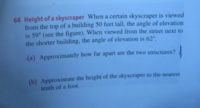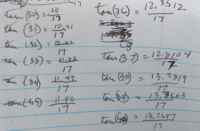allegansveritatem
Full Member
- Joined
- Jan 10, 2018
- Messages
- 962
here is the problem and the illustration:


What I did was to imagine what it would look like if the 50 ft building were raised to the same height as the skyscraper. What that would mean is: the 62 degree angle would become 90 degrees or the 62 dgree angle would collapse and be replaced by a 90 degree angle. Now, since raising the 62 degree angle by 3 degrees meant a 50 ft and since in order to go from 62 to 90 I have to traverse 28 degrees, I can divide 28 by 3, getting 9.3 and multiply that by 50 and thereby get the height of the building, namely 465 ft. Then it is an easy matter to find the distance from base of 50 ft building to base of skyscraper by dividing 465 ft by tan 62, which equals: 247.24 Is my reasoning correct? Or am I presuming that because a decrease of 3 degrees meant 50 ft of height, that this ratio will continue to hold all the way up? I mean, I don't actually know the rate will be 50 ft gain per three degrees lost. Also, I'm not sure just how to explain this business of the 62 degree angle changing to 90 degrees. I mean, what is the terminology I'm looking for?


What I did was to imagine what it would look like if the 50 ft building were raised to the same height as the skyscraper. What that would mean is: the 62 degree angle would become 90 degrees or the 62 dgree angle would collapse and be replaced by a 90 degree angle. Now, since raising the 62 degree angle by 3 degrees meant a 50 ft and since in order to go from 62 to 90 I have to traverse 28 degrees, I can divide 28 by 3, getting 9.3 and multiply that by 50 and thereby get the height of the building, namely 465 ft. Then it is an easy matter to find the distance from base of 50 ft building to base of skyscraper by dividing 465 ft by tan 62, which equals: 247.24 Is my reasoning correct? Or am I presuming that because a decrease of 3 degrees meant 50 ft of height, that this ratio will continue to hold all the way up? I mean, I don't actually know the rate will be 50 ft gain per three degrees lost. Also, I'm not sure just how to explain this business of the 62 degree angle changing to 90 degrees. I mean, what is the terminology I'm looking for?
Last edited:




